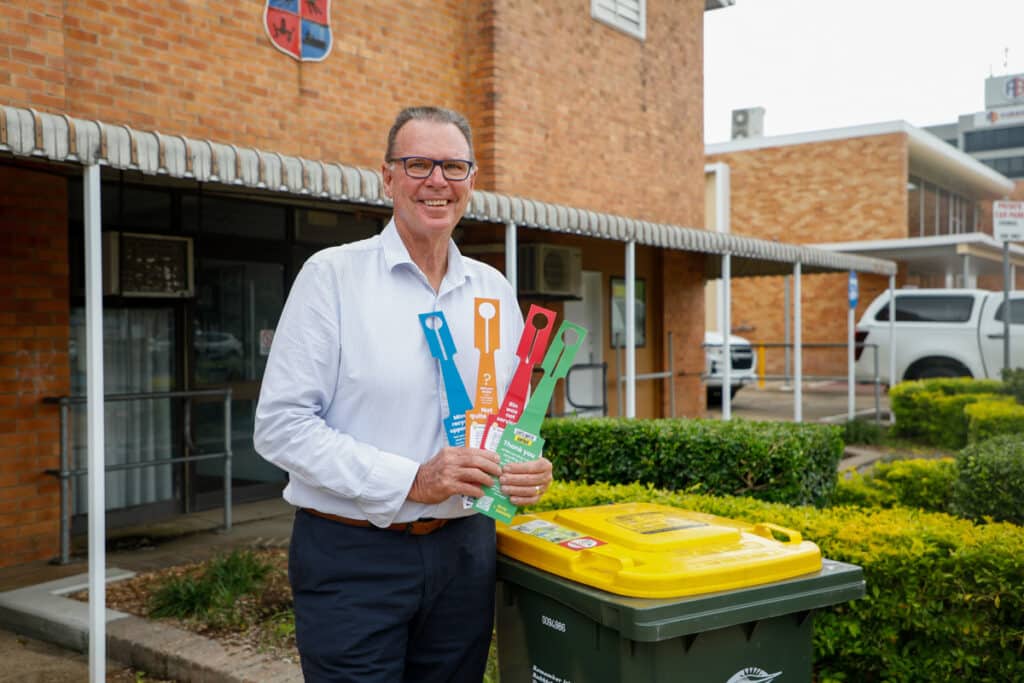
From March residents may notice coloured tags popping up on their kerbside collection bins and it’s all part of a new bin inspection program aimed at improving recycling and reducing contamination.
Bundaberg Regional Council, with support from the Queensland Government, is launching the program as part of the Let’s Get It Sorted campaign which seeks to help residents properly sort their waste to ensure more items are recycled correctly.
It comes after a recent audit revealed the following trends in waste management in Bundaberg:
- 18% of the contents in the yellow recycling bin are contaminated (e.g., plastic bags).
- 11% of items placed in the general waste bin are recyclable.
- 1 in 3 households are placing batteries in their bins, which can cause fires in garbage trucks, landfills, or recycling facilities.
Water, Waste, and Renewable Economy portfolio spokesperson Cr Gary Kirk said the program was all about education and awareness.
“Contamination in our recycling bins not only undermines the efforts to improve recycling rates but can also lead to potential hazards like fires from batteries or unsafe items in the waste stream,” he said.
“It also affects staff from Impact Community Services who hand sort the region’s recycling.
“This is why it’s crucial that residents understand exactly what goes where.”
How the Let’s Get It Sorted program works

The bin inspection program will begin in March, with inspections conducted at random by Council staff or contractors when bins are placed on the kerb for collection.
There will be two types of inspections:
- Staff will check the contents by lifting the lid to assess the items inside.
- Garbage truck drivers will assess bins using surveillance cameras on the truck while collecting or emptying them.
Staff will be checking for a range of issues including recyclables in waste bins, contamination, unsafe or unsuitable bin placement, hazardous items, overflowing bins and more.
If any of the above issues are found, a coloured bin tag will be placed on the bin, with a corresponding message explaining the issue and providing relevant information.
A green tag – means you have done a great job
An orange tag – means there are some things to improve on
A red tag – means your bin was not serviced because it contained too many incorrect items or was not presented for collection correctly.
A blue tag – means there are improvements you can make to your waste management practices
Cr Kirk said the program was about educating residents while ensuring that everyone understood the impact of improper waste disposal.
“We all have a role to play in protecting our environment, and that starts with how we sort our waste,” Cr Kirk said.
“Council is hoping to hand out as many green tags as possible to those residents who are doing a great job!
“By educating our community and reducing contamination in recycling bins, we can help reduce landfill waste and improve recycling outcomes for Bundaberg.”
Find out more here.
This initiative is proudly supported and funded by the Queensland Government’s Let’s Get It Sorted program.
Other news:





So does a red tag mean council will not collect your rubbish bin even though you pay on your rates.
Is spending extra on this program going to save money in the long run?
Maybe it’s time we invested in our own recycling plants take advantage of the fact that no one trust worthy & capable is buying our recyclable garbage. Turn it into a reusable state here in Bundaberg or even refill it here in Bundaberg. We usto have a Cocoa Cola factory. We even had smiths chips factory. We have heaps of empty warehouses & old factories that could be used.
Think of the jobs it would create if we didn’t just sort it should also reduced cost & environmental impact of transporting our waste to other facilities. This is the sort of facility that would not discriminate on the 50+ year olds when hiring that make up the bulk of the long term unemployed. Other cities near us could send there recyclables to us as well if we had capacity to take it.
Reminder with containers for change if you don’t care about the piddly amount of money you could donate it to a charity either yourself or through there payment system. There is currently 25 charities in Bundaberg that would like your donations listed on containers for change website.
@Daniel Compostable Food & Green waste is going to end up costing us $28 million/year extra in time. Getting people to compost or hall there own or use a mowing service or skip that will do it for them saves us a substantial amount of money. There also trialing a Food & Green waste bin in some areas but if we did things as suggested this would not be needed saving us even more money.
Eventually recycling returns will likely over take the capacity of the main facility as well costing extra to run. Getting people to use containers for change would save on operational costs of this service. We might be able to reduce recycle bin collection to once a month if people washed there recycling.
Finding ways to recycle other products can even get you payed more places like Shaws & ABC recycling takes a variety of recycling metals. Officeworks has a drop off point for technology as you go in the door.
So it could save council $28 million+ PA while putting potentially $1.5 million+ PA back in our pockets.
–
It’s about being ignorant of what has happened. In wake of China banning our recycling 7 years ago you should have…
1. Converted the Green bin to garden waste & vegetable scraps. This gets mulched & or composted & sold to our farmers. We could also have a donate compost bin contents day to help farmers where a truck comes around & collects the contents of compost bins.
2. Covered the yellow bin to everything else. This goes directly to landfill.
3. Got rid of containers for change.
Keep dangerous goods & high value goods that can be sold off the list & have them sent into appropriate services.
In order for us to meet the contamination level China wants of under 0.05% contaminated you should wash them out with left over dish washing or dish rinsing water to not waste water. This will help to meet the target.
Removing labels from containers may also help if you can do it easy enough – Ignore this for containers for change products.
The recovery rate for plastics is only about 13%. – 87% of it is being dumped. Yellow bins & public recycling bins are essentially useless for getting plastic recycled. They should make all plastic containers eligible for containers for change program. https://envirobank.com.au/this-is-100-clean-recycling/
Lets say I wash a ice cream container it is clean but the truck is not clean it can get contaminated on the way to the recycling center.
–
Removing recycle bins in public places is probably a good idea as well. Take it home, rinse it & get the 10 cents. Public recycle bins are filthy.
How about getting tourism & hospitality businesses to participate in this 10 cent program? It could be hundreds of dollars or more every week for them. How many alcohol bottles could a pub bring in?
If we start putting 576,000 extra containers into containers for change a fortnight that is a huge demand on the very small amount of operators we have. This could create a heap of jobs at there facilities & more facilities could open up.
The extra jobs would allow workers to spend more money it would have a flow on effect to our shops. This is on top of the benefits already discussed by others. We could be missing out on millions worth of economic activity because of the use of yellow bins for plastic.
Using a process called pyrolysis we could turn plastic into fuel like diesel or gasoline. This would require the construction of a plant capable of undertaking the work necessary to convert the plastic into fuel. This would also create jobs.
This would piratically make a renewable version of diesel or gasoline and reduce our reliance on buying from overseas. Australia is always short on our fuel reserves.
–
The term there throwing around now is up-cycling where we increase the value of recycling by making more worthwhile products out of them. Meaning we can recycle in our own country. Fuel from pyrolysis certainly fits the bill.